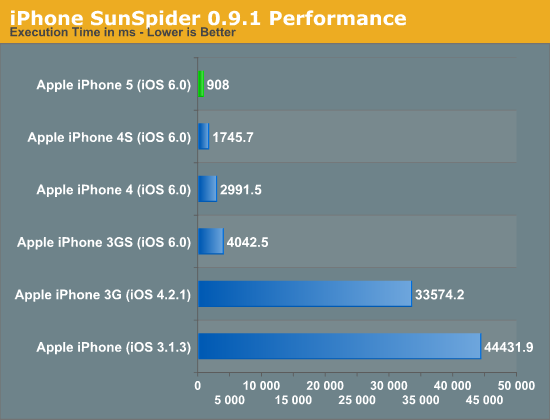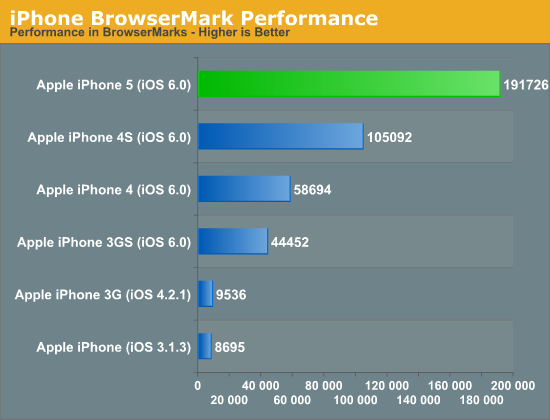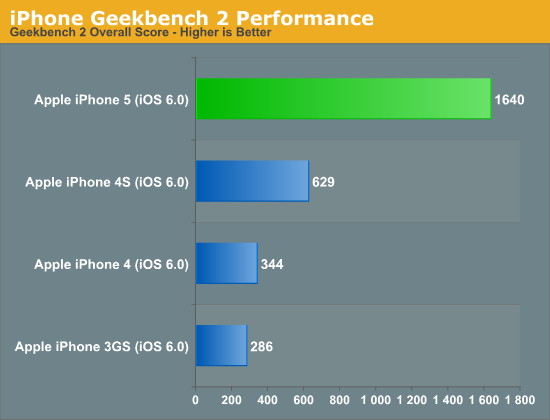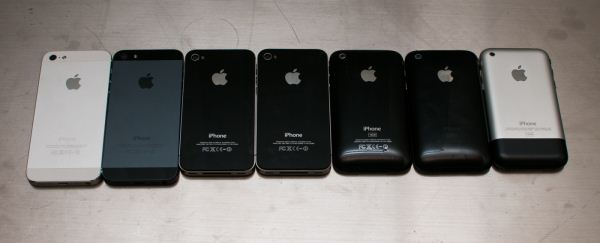The iPhone 5 Review
by Anand Lal Shimpi, Brian Klug & Vivek Gowri on October 16, 2012 11:33 AM EST- Posted in
- Smartphones
- Apple
- Mobile
- iPhone 5
Six Generations of iPhones: Performance Compared
Section by Anand Shimpi
Cross platform smartphone benchmarks are interesting, but they do come with their own sets of issues. Before we get to that analysis however, let's look at how the iPhone's performance has improved over the past six generations. Luckily Brian has a set of all of the iPhones so he was able to run a few tests on all of the devices, each running the latest supported OS.
We'll start with SunSpider 0.9.1, our trusty javascript performance test:

The transition from iPhone to iPhone 3G shows you just how much additional performance you can squeeze out of simply a software change. There's likely even more that could be squeezed out of that ARM11 platform, unfortunately newer versions of Safari/iOS aren't supported on the iPhone 3G so we're left with a runtime that's around 37x the length of a single run on the iPhone 5.
The rest of the devices support and run iOS 6, so we're at least on a level software playing field. The performance boost from one generation to the next is quite significant still. Going by this chart alone, the best balance of minimal upgrades and maximum perceived improvement would be from the original iPhone to the 3GS then again from the 3GS to the 5.

The BrowserMark results tell a similar story. The jump from the ARM11 based iPhone/iPhone 3G to the 3GS running iOS 6 is huge. Both the 4S and 5 offer doublings in performance, albeit for different reasons. The 4S delivered a doubling thanks to a doubling of core count and a move to the Cortex A9, while the iPhone 5 doubled performance through a much higher clock speed and microarchitectural improvements.
Finally we have Geekbench 2, which only runs on the iOS 6 supported devices so we say goodbye to the original iPhone and iPhone 3G:

None of the jumps looks as dramatic as the move to the iPhone 5, but we already know why. The Swift CPU architecture does a great job improving memory performance, which shows up quite nicely in a lot of the Geekbench 2 subtests.
On the PC side we often talk about 20% performance improvements from one generation to the next being significant. It's clear that the mobile SoC space is still operating along a hyper Moore's Law curve. The rate of progress will eventually slow down, but I don't see that happening for at least another couple generations. The move to ARM's Cortex A15 will be met with another increase in performance (and a similarly large set of power challenges), and whatever comes next will push smartphones into a completely new category of performance.












276 Comments
View All Comments
TrackSmart - Wednesday, October 17, 2012 - link
Shouldn't the battery life on the Verizon Galaxy SIII with LTE be higher than shown? That result bunches up with the 3G scores rather than the LTE scores. I wonder if the "LTE" listing is a typo.It's also a bit surprising how much of a difference the connection speed makes (3G vs 4G LTE) for the battery life tests. Are you guys really testing differences in power efficiency under typical use? Or have you, inadvertently, created a strange test of air interface throughput/watt - which would vary based on signal strength and network speed, but not based on the main device power draw under typical browsing (i.e. screen + intermittent CPU usage spikes).
I would have guessed that that screen power draw would be the largest cause for differences between handsets, not the air interfaces on the new devices, now that LTE is no longer a power hog.
phillyry - Sunday, October 21, 2012 - link
If it's anything like the Telus GS3 up here in Canada than it's not likely a typo. My brother has it and it tanks so bad on LTE that he keeps it turned off. Same thing with NFC btw. Two major selling features of the GS3 that went down the tubes in reality.Skidmarks - Wednesday, October 17, 2012 - link
I've got to hand it to Apple, if nothing else they sure know to market their rubbish.Freakie - Wednesday, October 17, 2012 - link
I haven't seen the 5 in person, but every time I see a picture of the front of it, I swear its design echos Samsung devices quite a bit. If any light hits it directly then it looks off-black, at least in the pictures, to the point of looking like Samsung's Pebble Blue color back when it was a bit darker (Samsung Impression).They got rid of the band around the phone and just have a slanted surface which when looking at pictures taken 8 inches away from the phone, has it's sharp "edges" that it slants to become one smooth transition. Reminds me a lot of the GSII's front.
Now I'm not a fan of any design litigations going either way, but I've never seen a Samsung device echo the looks of Apple's devices quite as much as the iPhone 5 echos a number of Samsung's design flairs that they've been using for a while.
Just my two cents xP
kmmatney - Wednesday, October 17, 2012 - link
Are you kidding me. Look at how much the original; Samsung Galaxy copies the iPhone 3G. Same with the Galaxy SII.See for yourself
3G versus SGI
https://encrypted-tbn1.gstatic.com/images?q=tbn:AN...
and 4S versus SGII
http://www.gizmowatch.com/entry/comparing-mights-i...
medi01 - Wednesday, October 17, 2012 - link
Wow, SGII and 4S have the same screen ratio, you shameless iScum...Freakie - Wednesday, October 17, 2012 - link
Oh I never said that Samsung hasn't produced a phone similar to an iPhone, though your second picture is pretty ridiculous (that's the SGI not SGII) which came out several months before the 4. Not only that but the picture its self is most definitely shot/edited in a way to make them as similar as possible.My complaint is just Apple doing something very different than normal, and echoing someone else for a change. Usually they seem to go for something different than the rest and the iPhone 5 most definitely does not come anywhere near that.
steven75 - Wednesday, October 17, 2012 - link
This is probably the most silly comment I've read among any iPhone reviews. iPhones have always been similar overall since the revolution if 2007 and now you are seriously making the claim this looks more like a Samsung device?/smh
MNSoils - Wednesday, October 17, 2012 - link
Apple has an interesting story here and your group did a wonderful job telling it.On the 2 graph of the "Increased Dynamic Range" page, the idle power for the Tegra 3 SOC after finishing the Kraken benchmark seems awfully high for just the companion core. Does more time have to elapse before Android reverts to the companion core? Is the companion core not that power efficient (power-gated, etc.)? Does Android revert to the companion core?
colonelclaw - Wednesday, October 17, 2012 - link
Thanks for a terrific article. It's just a shame that about 75% of the comments will be by people who either love the device or hate it, and nothing in this carefully researched and written appraisal will make them change their minds either way.How did we get to this? Actually, don't answer, that would turn into an irrelevant pissing match too.